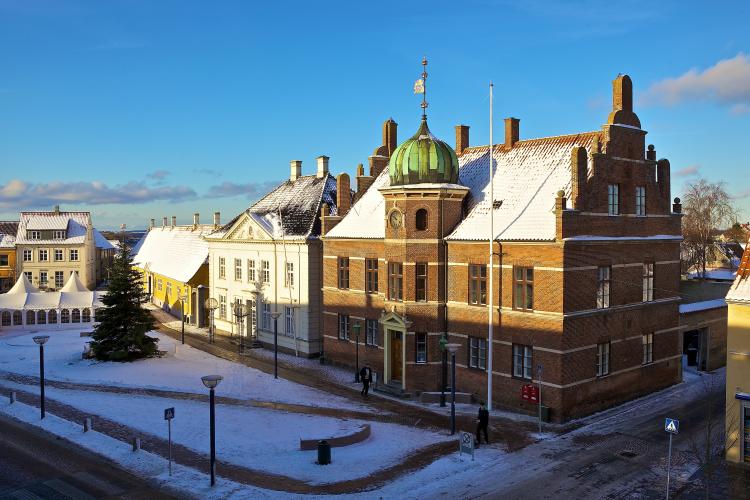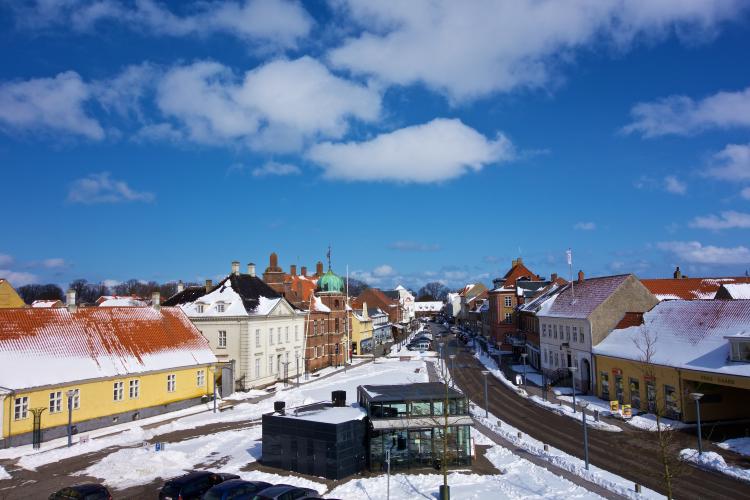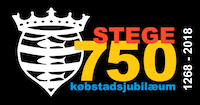Old Town Hall
The stately house on the corner of Rådhusgade and the town square was designed by one of Denmark’s most famous architects M.G. Bindesbøll, and as such built as Stege’s Town Hall in 1854. It functioned for many years as a courtroom as well as a police station, in the times that all market towns still had their own police station. Now, the premises have been purchased by a local fund, the ‘Liselund Fountain’ leading to its restoration in its original colours. It functions on a daily basis as offices for small businesses.
In the late Middle Ages, Stege had another town hall, which defined the square to the northeastern side, but the Swedes burned it down in 1659, whereby most of the town papers were lost. However, the book of Stege was saved, in which “it is proclaimed that in the year of the Lord 1418 on St. Jörgens, the famous martyr's day (April 23), this book was made. That, by Johannes Verkentin, who at that time was the mayor in town, with the consent of all councillors and residents in Stege. Pray for them!’
The medieval town hall was built in the heydays of Stege in the 1400s. A large and stately, probably with a two-storey main building, which bounded the square to the northeast, and a lower underlying market hall. The stones of the building were found during excavations connected with the town square renovation around 2000; the stones have been left underground.
Storetorv – the main town square - has existed since Stege’s earliest years. It has been said that the church and the trade are the only ones that have been here in all of Stege’s 750 years. The trade was - from the town's first years - concentrated in the area stretching from the harbour at the end of Dybsbrosstræde to the main square. Back then, Dybsbrostræde went all the way from the harbour to the square. One could see the town hall and the market stalls from down the street when reaching land. The main square has always functioned as the centre of Stege - and the centre of power, whether this being within the town hall, the merchant’s houses or the banks.
On the information plaque at Café Frederik VII, you can read more about Storetorv's history and get an idea of what the old town hall might have looked like.
Now, cross Rådhusgade and follow Storegade towards Mølleporten and stop at Gåsetorvet (i.e the goose square).
In 1697, just after the days of the evil Plessen, Stege's economic conditions were under the reorganization of a royally appointed commission, and there were only three merchants operating in Stege at this time. In 1760, the number had grown to 15 merchants and in 1870, one clearly saw the results of these people's endeavours, as the number had then grown to a total of none less than 40 merchants. In 1950 there were 66 tradesmen and nowadays (2018), no less than about 70 shops exist within the town ramparts, despite a nationwide tendency of vast decline in the commercial life of small towns.
Steges' municipal charters were given in 1268, supporting trade as a whole. Until the late 1800s, each end of Storegade were supplied with a tollbar. In the custom house lying next to Mølleporten, a man methodically watched everybody passing with goods for the town like, for example, bundles of straw for a family in need of new straws for their bed or for animal bedding. If you were good friends with a person in town who needed straw, it was tempting for both parties to hide a delicious homemade sausage or a cask of good, strong brandy inside the straw bundles. However, it was tough luck, if the man from the custom’s house searched the straw with his spear, ending up with a spiked sausage at the end or a whole in a brandy barrel! Then there was certainly duty to pay for the importation.
You are now almost reaching Gåsetorvet, but before then, you pass the butcher - Stig og Co's combined shop and restaurant, ‘Støberiet’. This is very exotic, as you can buy almost any kind of meat - besides the known species you can buy meat from wild boar, crocodile, deer and kangaroo. Some years ago, an antique shop was situated next to the butcher shop. The yard space between the two stores was then covered, so you could sit and eat whilst being tempted by some of the furniture or other antique items. It is still possible to purchase the furniture or different items in there, as they all have a price.
Now, you have Gåsetorvet i front of you.
54.985088, 12.285916
Loading...
This content requires HTML5 with CSS3 3D Transforms or WebGL.





